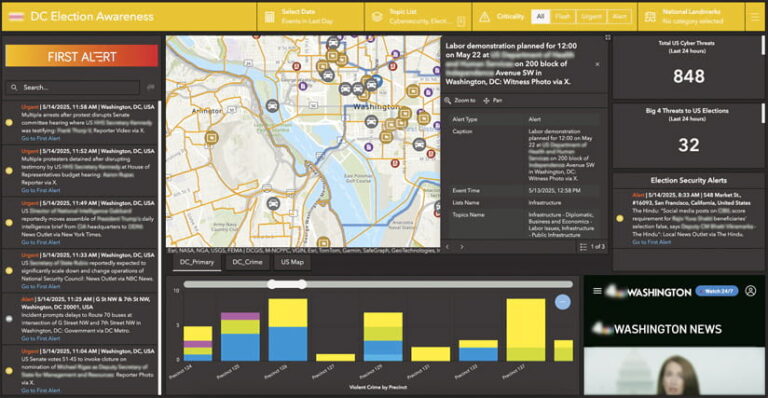Securing major events, such as world-renowned sporting competitions or national elections, is a complex undertaking. These events involve large numbers of people and present significant security challenges. By leveraging effective technologies, event organizers can create powerful tools that enhance preparation for, responses during, and analysis after big events.
In particular, event organizers can integrate Esri partner Dataminr’s AI-powered real-time risk detection tools with Esri’s advanced GIS mapping and location intelligence products to improve their security strategies at every stage of an event. Here’s how this cutting-edge technology combination works.
Pre-Event Planning: Lay the Groundwork for Success
Preparation is critical for major event security. Technological solutions that help organizers anticipate risks, allocate resources, and coordinate effectively are essential.
Identify Threats Early
The key to identifying threats early is investing in an AI-powered real-time information platform that can process millions of public data sources—such as social media, public sensor data, audio scanners, the deep web, and the dark web—to detect emerging risks, events, and threats and notify organizations before they escalate. This proactive approach gives organizers the lead time they need to prepare for potential security threats, traffic disruptions, or weather hazards.

Leverage Location Intelligence
Having a GIS that can bring together historic and real-time data to uncover patterns, such as crime hot spots or high-traffic zones, is imperative for building a strategic security plan. The ability to layer this information on maps allows stakeholders to visualize potential vulnerabilities and plan around them.
Before a major sporting event, for example, organizers can use GIS to dynamically create and adjust map views of key areas such as athlete housing and stadiums. These map views can be paired with real-time risk intelligence to give organizers a comprehensive understanding of potential threats and their context.
Optimize Resource Deployment
By combining real-time intelligence with geospatial data, organizers can efficiently distribute security personnel and resources to the most appropriate places. Using GIS software and apps, they can model traffic flows, simulate crowd movements, and create detailed digital replicas of event venues. During an election, for instance, local authorities can pinpoint polling stations that expect high foot traffic and prioritize sending security officers there.
Enhance Collaboration
Large-scale events often span multiple jurisdictions and require coordination across agencies. Ensuring that various stakeholders receive real-time alerts and use centralized mapping tools facilitates data sharing between mobile teams, law enforcement, and other security organizations—ultimately enabling unified preparation.
During the Event: Maintain Situational Awareness in Real Time
Once the event begins, the focus shifts to live monitoring and rapid response. By leveraging real-time information from Dataminr in GIS-based dashboards, organizers can ensure that they stay a step ahead of potential disruptions.
Detect Risks in Real Time
AI-powered real-time risk detection tools that synthesize text, images, video, sound, and machine-generated sensor data excel at spotting anomalies and threats as they happen. Effective tools alert key personnel about situations such as public disorder, safety risks, or rapidly evolving weather conditions. These alerts can be integrated into an organizer’s operational workflows, giving staff working the event seamless access to critical insight.
Improve Situational Awareness
Spatial analysis enables event teams to visualize threats in the context of geography. For example, during an international sporting tournament, organizers can use ArcGIS Online, ArcGIS Enterprise, ArcGIS Velocity, and the ArcGIS Solutions Watch Center solution to closely monitor potential disruptions like structure fires or violent altercations near stadiums and adjacent areas. Combining this with hyperlocal insight delivered by real-time risk detection tools, decision-makers gain a complete picture of unfolding events.
Make Decisions Rapidly
Equipped with real-time intelligence, organizers can quickly prioritize actions and redeploy resources to high-risk zones when needed. For instance, if transportation routes near a venue become congested, GIS software and apps can suggest alternative paths for attendees and notify traffic control teams about how to manage the situation.
Coordinate Across Departments
Since major events often involve overlapping jurisdictions and differing levels of authority, minimizing delays and confusion is key. Incorporating real-time intelligence and mapping solutions into existing workflows gives stakeholders seamless communication.
Real-World Examples
During a recent high-profile international sporting event, organizers used Dataminr and Esri technology to create map-based dashboards to address isolated security threats and ensure safe crowd dispersal. Similarly, during recent national election events, AI-powered tools and GIS technology from Dataminr and Esri provided election security teams with insight into disruptions and helped them ensure voter safety.
Post-Event Analysis: Learn and Adapt for the Future
Once an event ends, conducting post-event analysis is essential. Technology that combines AI-powered real-time risk detection with geospatial capabilities allows data to be archived, visualized, and analyzed. Teams can then assess how they managed risks, where gaps existed, and what worked well. After an election, for instance, crime data collected near polling stations can help security teams improve officer deployment strategies for future elections.
Learn from Anomalies
Gaining post-event insight isn’t just about resolving past issues; it also helps event organizers and security teams prepare for the future. For example, if a venue faced challenges with evacuation during an emergency, using ArcGIS to develop a digital twin of the venue could help organizers model and test alternative evacuation routes.
Reuse and Refine Security Plans
Major event security plans are complex, comprehensive, and time-consuming to develop. The ability to save, adapt, and reuse security plans for future events offers immense value. These plans, enhanced by Dataminr’s real-time intelligence integrated with ArcGIS, create a record that reduces preparation time and improves outcomes for future events.
A Cohesive Operational Environment
The complexities involved in putting on large events today present organizers with a range of challenges—from dealing with large, dense crowds that can be targets for disruptive activities to coordinating events that take place in multiple locations and require coordination across private and public-sector organizations. These challenges can be addressed by integrating multiple tools and bringing various teams together in a common operating picture.
The value of effectively combining modern geospatial and AI-powered technology includes the following:
- With GIS-based digital twins, organizers can simulate venues to test scenarios and refine their security strategies.
- Organizers can leverage AI-driven location intelligence to contextualize threats specific to certain venues or event configurations.
- Systems can be scaled to meet the needs of events that range from local get-togethers to international gatherings.
Best Practices for Securing Major Events
Drawing from experience, the teams at Dataminr and Esri have developed several best practices for planning and hosting big events:
- Prioritize collaboration: Establish partnerships across agencies early in the process and maintain a unified operating picture.
- Leverage real-time insight: Use AI-driven alerts and GIS mapping to stay agile during live events.
- Plan for the long term: Develop security plans with future reuse in mind, incorporating lessons learned from past events.
- Invest in innovation: Harness the latest tools, such as GIS-based digital twins and AI, to stay ahead of emerging challenges.
Major events always require a robust and multilayered security strategy. GIS combined with AI-driven insight helps organizations plan smarter, act faster, and adapt better to potential risks.


